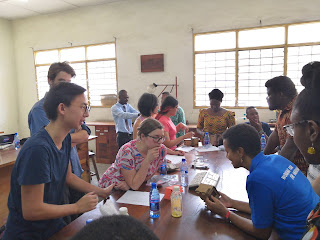It's hard to know what to expect when checking in on the
status of our customers and machines in the field–there can be failures both
mechanical and in communication. But seeing these situations first-hand is vital
to QueenTech’s development since it exposes details about our machines and
operations that we could never have anticipated. As time goes on, we establish
clearer business practices and our machines stay in the field longer. We went
into the field this weekend ready to learn as much as we could from our
observations, and to apply that knowledge to future work.
 |
| Naomi, our newest customer with her newly purchased grater and press |
Our first stop was the delivery of machines to our newest
customer, Naomi. Womentum provided funding to set her up with a grater and press
from us as well as a stove from Burro to jumpstart her gari-making business.
Another woman in her village had already been processing cassava for a few
months using QueenTech's equipment, so Naomi was familiar with it. While we set
up her new machines and talked to her about the funding she was receiving, some
members of our team addressed issues our established customer was having with
her press. We knew that the nuts on our press had to be frequently replaced,
because the fine dust in the air would strip the threads after many uses. In
our previous design, the nuts were welded to the handles that tighten the press.
We recently reimagined the nuts to be removable from the handle, however, so
that only the nut, and not the whole handle, would need replacement. When our
established user on Saturday showed us that her handles had stripped, we
cleaned the lead screws on her press and replaced the handles with our new
design. Now she will be able to simply buy new nuts if they strip again, rather
than waiting for us to deliver her entirely new handles.
 |
| Debbie, Chief Executive of QueenTech, demonstrating to our new customer how to use the press |
Our next stop was to pick up a press prototype that was
being testing by one of our long-term users, Adjoa. This press used a locking
bar rather than a lead screw on one side, which cut much of the cost of lead
screws and frequent nut replacements. However, we learned from this and other
users that once most of the liquid was pressed out of a bag of cassava, this
press design was unable to apply enough pressure on its locking bar side to
evenly squeeze out the remaining moisture. Because of this, we decided in the
semester before our trip that we wouldn't move forward with the design.
 |
| The team, Akosua, and Kingsford |
After stopping for a quick grater inspection in a nearby
village, we concluded our user visits for the day at the home of a longtime
user (and champion prototype tester), Akosua, and her husband, Kingsford. There,
arranged carefully in the yard, were four versions of our press from different
stages of its development. The first was a tall, sturdy table with lead screws
that folded down. “We like this one best,” said the husband, smiling, “because
it’s so big.” We’ve found that size is a recurring theme working on machines in
rural areas—people care a lot about durability because if something goes wrong,
it can take time to get out there and fix it, and they also want to be able to produce
a lot of product when the raw material is available. We took off the pressing
boards and compared them with those of the newest press design, revealing that
the new ones were actually slightly larger. But we were reminded that this
model had longer lead screws for more capacity, plus one more difference:
 |
| Four of our press designs that Akosua has been testing over the years |
“It's
the legs,” our user’s husband said. There was no arguing with this; the old
design had four long, solid legs, while the newest one only had two with feet
that spread out at the bottom. We’d never seen any issues related to the
strength of these legs, but the perception of size and strength was an
important factor that our users mentioned over and over. It didn't matter that
the newest design could hold more cassava; it looked smaller so was less
preferred. “And it doesn't press as well on the side with the bar,” said our
user’s husband. This wasn't news, but it supported the decision we’d made to
move away from that iteration. It was a very clever design that past team
members had put hard work into, so we were sad to see it go, but glad to come
away from our field testing with valuable lessons that informed the direction
of our future design work.
 |
| The four-legged press from years past |
For years, our team has met with the chiefs of communities
we wanted to work with—this is a required practice that helps keep unwanted
influences from bringing chaos and corrupting local ways of life. Over time,
this has become unnecessary, and we are truly grateful for this trust and the
opportunity to learn—about building
machines, about conducting business, and the many ways that people live in the
world.




